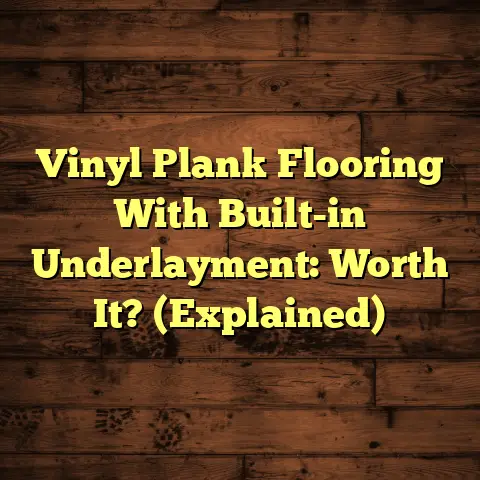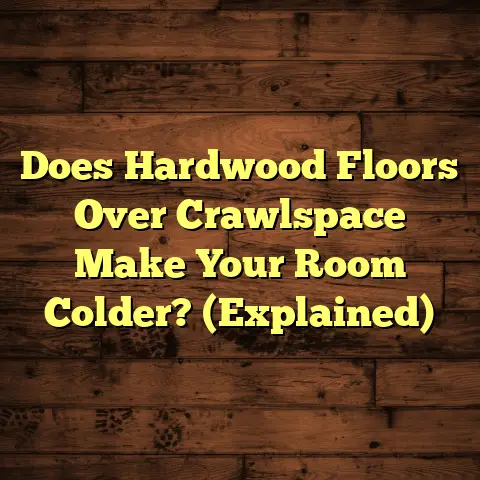Uneven Floors In Old Houses: What’s The Cause? (1 Hazard!)
There’s something undeniably special about owning a home with history, isn’t there?
The creaky floors, the quirky nooks, the sense that you’re living in a space that has witnessed generations of stories.
But let’s be real, that charm often comes with its own set of unique challenges.
One of the most common? Uneven floors.
I’m John, a flooring contractor with over 20 years of experience, and I’ve seen it all.
From slight slopes to downright bouncy spots, I’ve diagnosed and repaired countless uneven floors in old houses.
In this article, I’m going to share my expertise with you, breaking down the causes of uneven floors and explaining why it’s not just a cosmetic issue.
Trust me, understanding what’s going on beneath your feet can save you a lot of headaches (and money!) in the long run.
So, grab a cup of coffee and let’s dive in!
Understanding Uneven Floors
First things first, what exactly do I mean by “uneven floors?”
It’s more than just a slight imperfection.
We’re talking about floors that visibly slope in one direction, sag in the middle, or feel bouncy when you walk across them.
You might notice furniture wobbling, doors that won’t close properly, or even cracks in the walls.
These are all telltale signs of an uneven floor.
Think of it this way: a perfectly level floor is like a calm lake.
An uneven floor?
More like a choppy sea, with waves and dips all over the place.
Now, while a little character can be endearing, significantly uneven floors can affect both the aesthetics and the functionality of your home.
Imagine trying to install new kitchen cabinets on a floor that’s sloping – not fun, right?
But more importantly, uneven floors can be a warning sign of underlying structural problems.
They’re not just cosmetic issues.
They can indicate foundation problems, wood rot, or even pest infestations.
That’s why it’s crucial to understand the causes behind these issues and address them promptly.
The Historical Context of Old Houses
To truly understand why uneven floors are so common in old houses, we need to take a trip back in time.
Think about the construction methods and materials used decades, or even centuries, ago.
They’re often vastly different from what we use today.
For example, old homes often have foundations made of stone or brick, which are more susceptible to settling and shifting than modern concrete foundations.
The framing might be made of old-growth lumber, which is incredibly strong but can also be vulnerable to moisture and pests.
And let’s not forget about the historical factors that contribute to the settling and shifting of homes over time.
Changes in land use, climate, and even the vibrations from nearby traffic can all take their toll.
Did you know that the average lifespan of a wood floor joist is around 75-100 years?
That means that in a house built in the early 1900s, those joists are nearing the end of their lifespan and may be starting to show signs of wear and tear.
Think about the environmental changes those materials have endured over the years: harsh winters, humid summers, and countless cycles of expansion and contraction.
It’s no wonder that uneven floors are such a common problem in old houses!
Common Causes of Uneven Floors
Alright, let’s get down to the nitty-gritty.
What are the most common culprits behind uneven floors in old houses?
I’ve broken it down into several categories:
-
Foundation Issues:
This is often the biggest offender.
Your foundation is the bedrock of your home, and if it’s compromised, it can lead to all sorts of problems, including uneven floors.
Settling is a common issue, especially in areas with expansive clay soils.
As the soil dries out and shrinks, the foundation can settle unevenly, causing the floors above to slope or sag.
Heaving, on the other hand, occurs when the soil expands due to moisture.
This can push the foundation upwards, creating bumps and unevenness in the floors.
Soil erosion is another major concern.
Over time, rainwater can wash away the soil around the foundation, weakening its support and leading to settling.
Different foundation types are also more susceptible to movement.
For example, pier and beam foundations, which are common in older homes, can be particularly vulnerable to settling if the piers are not properly supported.
I’ve seen cases where the piers have sunk several inches, causing significant sloping in the floors.
-
Structural Damage:
Wood rot and termite damage are two of the biggest enemies of old houses.
Wood rot occurs when wood is exposed to moisture for extended periods, leading to decay and weakening.
This can compromise the floor joists and subfloor, causing them to sag or collapse.
Termites, on the other hand, are insects that feed on wood, literally eating away at the structural integrity of your home.
I’ve seen cases where termite damage has been so extensive that the floor joists are completely hollow, making the floors incredibly bouncy and unsafe.
Other structural issues, such as damaged or undersized floor joists, can also contribute to uneven floors.
Sometimes, the original builders simply didn’t use adequate materials to support the weight of the house, leading to sagging over time.
-
Moisture Problems:
Water is the silent killer of old houses.
Water intrusion, poor drainage, and high humidity levels can all wreak havoc on your floors and foundation.
Water intrusion can come from leaky roofs, cracked pipes, or even just rainwater seeping in through the foundation.
Poor drainage around the house can lead to water pooling near the foundation, saturating the soil and causing it to expand or erode.
High humidity levels can promote wood rot and termite infestations, further exacerbating the problem.
I’ve seen cases where homeowners have unknowingly had a slow leak under their kitchen sink for years, leading to extensive wood rot in the subfloor and significant sloping in the floors.
-
Natural Settling:
Even without any major structural issues, homes naturally settle over time.
This is especially true in the first few years after a house is built, as the soil compacts and the foundation adjusts to the weight of the structure.
While some settling is normal, excessive settling can lead to unevenness in the flooring, especially in older homes where the foundation may not have been built to modern standards.
Think of it like this: your house is constantly shifting and adjusting, like a living organism.
Over time, these small movements can add up, resulting in noticeable unevenness in the floors.
The Hazard of Uneven Floors
Now, let’s talk about the potential dangers of living with uneven floors.
It’s not just about aesthetics.
Uneven floors can pose serious safety hazards, particularly in terms of tripping and falling.
Imagine walking through your house in the dark and suddenly stumbling because of a dip in the floor.
It’s a recipe for disaster, especially for young children and elderly adults.
According to the National Safety Council, falls are a leading cause of injury and death in the United States.
And uneven floors can significantly increase your risk of falling.
But the hazards don’t stop there.
If left unaddressed, uneven floors can lead to further structural damage.
For example, if your foundation is settling, it can put stress on the walls and roof, leading to cracks and leaks.
Wood rot and termite damage can also spread rapidly if not treated, compromising the entire structural integrity of your home.
And let’s not forget about the potential impact on property value.
A house with visibly uneven floors is likely to be worth less than a comparable house with level floors.
It can also make it more difficult to sell your home, as potential buyers may be turned off by the perceived problems.
Finally, your home insurance company may take issue with uneven floors, especially if they are caused by a known structural problem.
They may require you to fix the problem before they will renew your policy, or they may even cancel your policy altogether.
Case Studies
To illustrate the diversity of issues faced in different regions, let’s look at some real-life examples.
Case Study 1: The Sagging Victorian in San Francisco
I worked on a beautiful Victorian home in San Francisco that had a noticeable sag in the middle of the living room floor.
The homeowner had noticed that furniture would roll towards the center of the room and that doors wouldn’t close properly.
After a thorough inspection, I discovered that the foundation had settled unevenly due to the area’s unstable soil conditions.
The soil was a mix of sand and fill, which had compacted over time, causing the foundation to sink in certain areas.
To fix the problem, we had to lift the house and install new support piers under the foundation.
It was a major undertaking, but it completely resolved the sagging floor and restored the structural integrity of the home.
Case Study 2: The Bouncy Bungalow in New Orleans
I also worked on a charming bungalow in New Orleans that had incredibly bouncy floors.
You could literally feel the floor vibrating when you walked across it.
In this case, the culprit was termite damage.
The house was located in a humid environment, which created the perfect breeding ground for termites.
The termites had eaten away at the floor joists, leaving them hollow and weak.
To repair the damage, we had to replace all of the affected floor joists and treat the house for termites.
Case Study 3: The Sloping Farmhouse in Vermont
Finally, I worked on an old farmhouse in Vermont that had a noticeable slope in the kitchen floor.
The homeowner had been living with it for years, but it was starting to become a safety hazard.
In this case, the problem was a combination of wood rot and water intrusion.
The kitchen was located near a leaky roof, which had allowed water to seep into the subfloor over time.
This had led to wood rot, which had weakened the floor and caused it to slope.
We repaired the roof, replaced the rotted subfloor, and leveled the floor.
These are just a few examples of the many different causes of uneven floors in old houses.
Each case is unique, and it’s important to have a thorough inspection to determine the underlying problem before attempting any repairs.
Conclusion
So, there you have it – a comprehensive look at the causes of uneven floors in old houses.
As I’ve explained, it’s not just about cosmetic imperfections.
Uneven floors can be a sign of serious structural problems, posing safety hazards and potentially impacting your property value.
By understanding the common causes of uneven floors, you can take informed actions to protect your home and your family.
Whether it’s addressing foundation issues, repairing wood rot, or simply improving drainage, there are steps you can take to restore the stability and beauty of your floors.
And remember, old houses have character, so don’t be afraid to embrace the quirks and imperfections that make them unique.
But when it comes to uneven floors, it’s always best to err on the side of caution and address any potential problems before they become major headaches.
After all, your home is your castle, and it deserves to be safe, sound, and level!





